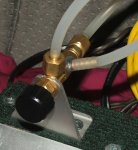Ok, here's the bottom line. If someone wanted to fly on a two stroke engine and just didn't want to spend much or any money on instrumentation to monitor the engine what one thing would be essential to it's safe operation? My answer is, In Flight Mixture Control. The problem with setting the mixture on an aviation two stroke, and mixture setting is THE basic key element in the equation, has the do with how it's set. Land the aircraft, pull open carbs, change jets, needles, etc, etc, which means you can't be running the engine while you are changing the mixture and that is the problem. What I have learned from using my mixture control is that I can set the mixture accurately by just listening to the engine, feeling the vibration, observing the rpm change, all possible because the engine is running while I'm doing it. Anyone who has flown R/C aircraft, which are mostly two stroke powered, would know how much more difficult it would be to adjust the engine mixture correctly if they couldn't do it while the engine was running. Manual mixture control turns the aviation two stroke into a big R/C aircraft engine, as far as mixture adjustment goes.
But, I still believe in monitoring the piss out of the engine.

